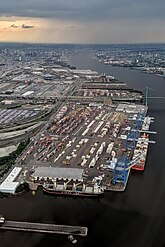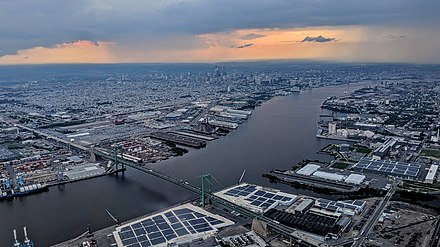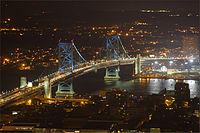-
Walt Whitman Bridge south side
-
Walt Whitman Bridge north side
-
Packer Avenue Marine Terminal
-
Night view
-
Aerial with Port of Camden at right
-
Walt Whitman monument at the bridge entrance
Walt Whitman Bridge | |
|---|---|
 Walt Whitman Bridge, connecting Gloucester City, New Jersey and Philadelphia | |
| Coordinates | 39°54′19″N 75°07′47″W / 39.90528°N 75.12972°W |
| Carries | 7 lanes[1] of |
| Crosses | Delaware River |
| Locale | Philadelphia, Pennsylvania to Gloucester City, New Jersey[1] |
| Official name | Walt Whitman Bridge |
| Maintained by | Delaware River Port Authority of Pennsylvania and New Jersey |
| ID number | 4500010 |
| Characteristics | |
| Design | Steel suspension bridge |
| Total length | 11,981 feet (3,652 m)[1] |
| Width | 92 feet 2 inches (28.09 m)[1] |
| Longest span | 2,000 feet (610 m)[2] |
| Clearance below | 150 feet (46 m)[3] |
| History | |
| Opened | May 16, 1957[1] |
| Statistics | |
| Daily traffic | 120,000 |
| Toll | $6.00 (westbound) (E-ZPass)[4] No toll for eastbound vehicles going from Pennsylvania to New Jersey. |
| Location | |
 | |
The Walt Whitman Bridge is a single-level suspension bridge spanning the Delaware River from Philadelphia in the west to Gloucester City in Camden County, New Jersey in the east. The bridge is named after American poet and essayist Walt Whitman, who resided in nearby Camden toward the end of his life.
Walt Whitman Bridge is 11,981 feet (3,652 m) in length, making it one of the larger bridges on the East Coast of the United States. The bridge is owned and operated by the Delaware River Port Authority.[1]
Overview
[edit]Construction on the bridge began in 1953,[1] and it opened to traffic on May 16, 1957.[1] The bridge has a total length of 11,981 feet (3,652 m),[1] and a main span of 2,000 feet (610 m).[2] The bridge has seven lanes,[1] three in each direction and a center lane that is shifted variably (via a zipper barrier) to accommodate heavy traffic.[5]
The bridge is a part of Interstate 76, which, between the Delaware River and the Pennsylvania Turnpike interchange in King of Prussia, Pennsylvania, is known as the Schuylkill Expressway; this was originally part of Interstate 676's route until it switched positions with I-76 in 1972.
Along with the Benjamin Franklin Bridge, which carried I-76 until 1972, and has carried I-676 since, the Betsy Ross Bridge, Delaware Memorial Bridge, Commodore Barry Bridge, and Delaware River–Turnpike Toll Bridge, the Walt Whitman Bridge is one of six expressway-standard bridges connecting the Philadelphia area with Southern New Jersey.
The bridge was designed by noted civil engineer Othmar Ammann.[2] The Walt Whitman statue by Jo Davidson was placed at the intersection of Broad Street and Packer Avenue, in Philadelphia near the approach to the Walt Whitman Bridge.[6]
Naming
[edit]The controversy that surrounded the naming of the Walt Whitman Bridge has been documented in a series of letters from members of the public held in the Kislak Center of the University of Pennsylvania. The Center summarizes the controversy, saying, "The bridge was meant to be named after a person of note who had lived in New Jersey, but some area citizens opposed the name 'Walt Whitman Bridge'...Many objecting to the choice of his name for the bridge saw Whitman's work as sympathizing with communist ideals and criticized him for his egalitarian view of humanity."[7]
Tolls
[edit]
A $6.00 one-way toll is charged to westbound passenger vehicles (less than or equal 7,000 lb (3,200 kg) gross vehicle weight) traveling from New Jersey to Pennsylvania.[4] A $18 credit will be given on a per tag basis for any New Jersey-issued E-ZPass tag that crosses one of the four DRPA bridges 18 times in a calendar month. Trucks, commercial vehicles, mobile homes and recreation vehicles (weighing at least 7,001 lb (3,176 kg) gross vehicle weight) pay $9.00 per axle. Seniors aged 65 and over with an NJ E-ZPass can use a discount program to pay $3.00 per trip.[8] There is no toll for eastbound vehicles traveling from Pennsylvania to New Jersey since 1992, when one-way tolls were instituted.
On July 17, 2024, the DRPA approved an increase in the toll for passenger vehicles from $5.00 to $6.00, which went into effect on September 1, 2024.[9]
Gallery
[edit]See also
[edit] Transport portal
Transport portal Engineering portal
Engineering portal Pennsylvania portal
Pennsylvania portal Philadelphia portal
Philadelphia portal New Jersey portal
New Jersey portal- List of crossings of the Delaware River
References
[edit]- ^ a b c d e f g h i j "Walt Whitman Bridge". Delaware River Port Authority. 2013. Archived from the original on November 12, 2017. Retrieved December 15, 2014.
- ^ a b c "Walt Whitman Bridge". Structurae – International Database for Civil and Structural Engineering. Ernst & Sohn. July 29, 2014. Retrieved December 15, 2014.
- ^ "Bridges and Cables" (PDF). Moran Shipping. Retrieved 3 April 2019.
- ^ a b "DRPA - Travel Info". Delaware River Port Authority. Retrieved September 4, 2024.
- ^ Comegno, Carol (November 21, 2017). "How do they do that? Moving the traffic barrier on Ben Franklin Bridge". Courier-Post. Retrieved October 10, 2022.
- ^ Fairmount Park Art Association (1974). Sculpture of a City: Philadelphia's Treasures in Bronze and Stone. New York: Walker Publishing Co., Inc. pp. 290. ISBN 9780802704597.
- ^ "Delaware River Port Authority records on the naming of the Walt Whitman Bridge". University of Pennsylvania. Retrieved April 19, 2023.
- ^ "DRPA - Travel Info". Retrieved 2024-09-05.
- ^ "DRPA - News and Media". Delaware River Port Authority. Retrieved 2024-09-05.
External links
[edit]- Delaware River Port Authority site Archived 2017-11-12 at the Wayback Machine
- Walt Whitman Bridge at Structurae







